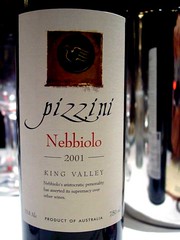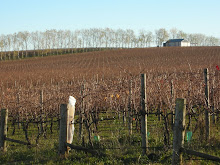
I mentioned in a recent post that Italy's nebbiolo grape variety is...well, pure bliss. I love nebbiolo, and I'm not afraid to say it. If it's nebbiolo aged in barrique, better again. I like to chew my wines and unfortunately at my sommelier course, our nebbiolo tasting is likely over as we have already looked at both Piedmont and Lombardy, which covers the two Italian regions that produce nebbiolo.
The first nebbiolo we tasted was a grand Barolo from Pio Cesare, from the 2003 vintage. This was a hot vintage in Italy, and produces wines that are perhaps less classic in style, though I appreciated this Barolo for its complexity. There was an ocean of perfumes, with plenty of varied spice dominating the nose.
The second nebbiolo was from the Valtellina, which can be considered the poor cousin of Barolo, though I like to think of it as great nebbiolo at more affordable prices. The Valtellina is home away from home for me, and it its, and my, hear, is nebbiolo. We tasted a sforzato, which is about as prestigious as you can get around these parts.
It was a Triacca, San Domenico sforzato, vintage 2003, and again it displayed an array of spices, though less vanilla than the Barolo. There were complex balsamic notes, leather and underbrush aspects, and the tannins were perfect to balance the 14.5% alcohol. Sforzato is made through a process of drying grapes, called appassimento, which is the same as the wine making of Amarone, to produce high alchol wines.
So, all in all I am satisfied with our tasting so far! I am having a visit home to Australia at Christmas and though it's not necessarily a wine for a hot summer's evening, I'll be keen to try some Australian nebbiolo when home.
Last week's wine of the week from Wine Pages, was a Trentham Estate La famiglia nebbiolo, from NSW. I'll leave aside what I think is becoming a stubborn insistence on screw cap in Australian wines (and I'd hesitate to describe nebbiolo as light-bodied), and say that the wine is intriguing all the same. It's matured for 18 months in French oak, so I'd expect some lovely soft oak characteristics. At this stage, I'd buy the wine for its beautiful label.
In addition, Franco Ziliani's WineWebNews from the Italian Association of Sommeliers celebrates this Australian wine industry experimentation with a post on Coriole's nebbiolo rose. That an Australian nebbiolo rose can make it to Italy with some positive news is a big step - the convincing is in the drinking. This is in addition to more well-known and successful efforts in Italian grape varieties from Pizzini.
So, could my love of nebbiolo be met on Australian shores too? Only time and plenty of tasting will tell...
Photo | Flickr
Labels: australian wine in italy, barolo, nebbiolo, valtellina


0 Comments:
Post a Comment
Subscribe to Post Comments [Atom]
<< Home